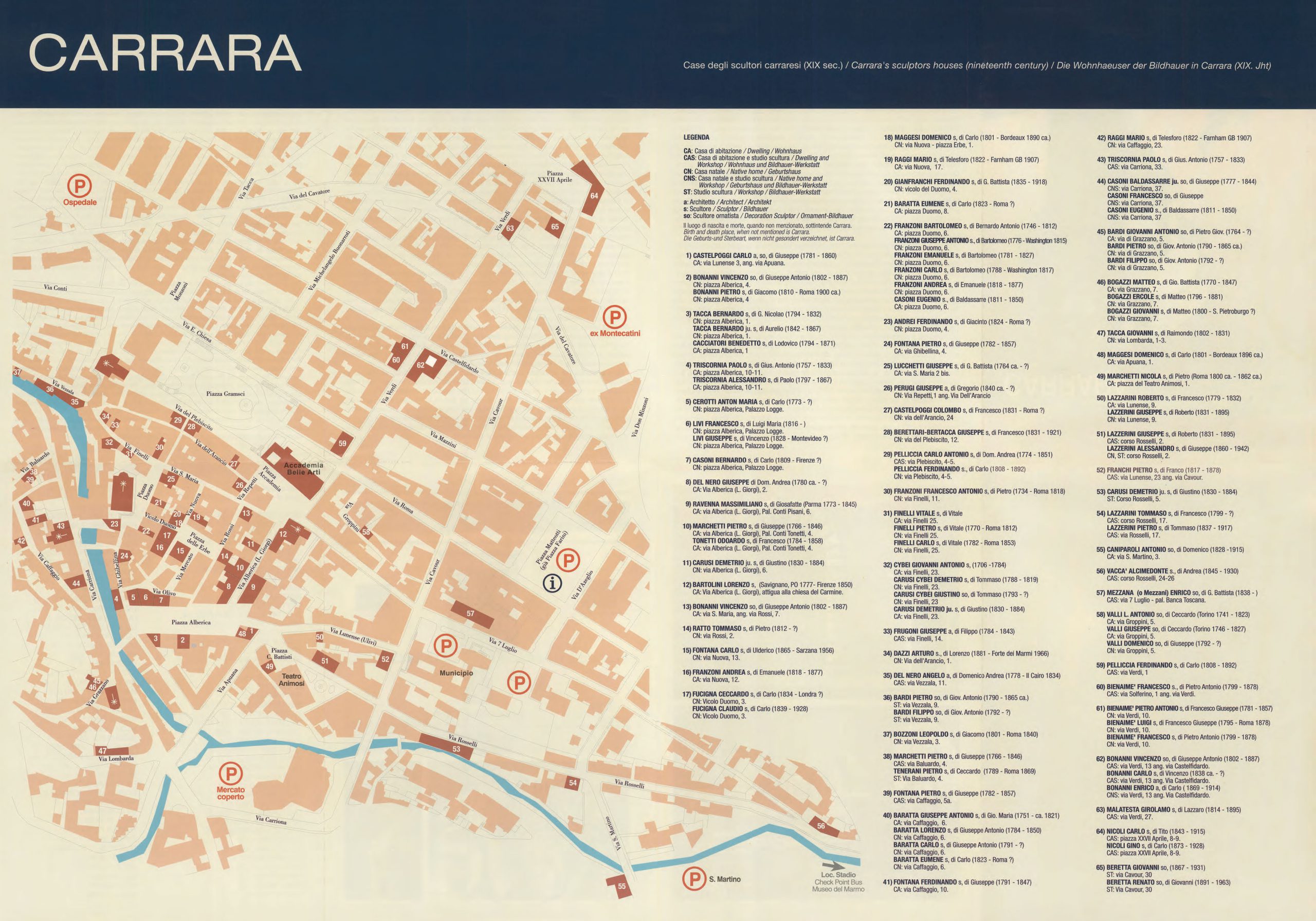La brochure in formato cartaceo è disponibile presso l'info point di Piazza Alberica
È a partire dalla prima decade dell’Ottocento, negli anni del dominio francese, tra il 1807 e il 1814, che la consuetudine molto antica della scultura in Carrara, diventa sempre più efficiente e organizzata. Anche l’Accademia di Belle Arti, che aveva conosciuto un declino, in anni di continuo disordine politico, viene pienamente ristabilita e, sotto la direzione di Lorenzo Bartolini, la scuola di scultura riprende vigore.
Le figure professionali della tradizione carrarese, si mostrano in grado di far fronte alle richieste della grande produzione monumentale celebrativa destinata all’impero napoleonico. Scultori come Paolo Triscornia, Francesco Lazzarini, Pietro Marchetti, Leopoldo Vanelli, Bartolomeo Franzoni, ecc., hanno quel profilo tecnico e quella sensibilità, che permette loro di essere esecutori capaci di tradurre in marmo opere altrui, dando alla materia quel senso necessario perché abbia nobiltà. Ma sono anche artisti capaci di creatività e quindi di alternare nella propria bottega gli aspetti di un artigianato raffinato ad una attività di propria invenzione. Si sono tutti formati culturalmente nell’accademia, esercitandosi fin dalla prima adolescenza nello studio progressivo del disegno e nella costruzione di modelli in creta.
Qui si apprende la storia dell’arte imitando gli esempi antichi, si osserva la natura e il vero copiando nella scuola del nudo, si studia la storia civile, la tradizione religiosa, la mitologia classica. Su questi temi si eseguono composizioni di propria invenzione, in una complessità sempre crescente. Nella scuola di architettura si apprendono tutti quegli elementi, soprattutto orientati alla progettazione di edifici monumentali o all’invenzione di parti decorative assai complesse. Quasi tutti trasferiscono questo bagaglio di conoscenze nella pratica del marmo, che non viene appresa in accademia, ma iniziata con un duro apprendistato nelle antiche botteghe.
Dopo la riunificazione dell’Italia, nel 1860, la ripresa economica, favorita dall’apertura dei mercati interni ed esteri, non trova la città impreparata e Carrara può offrire, nei cento laboratori attivi negli anni Settanta, un’industria artigianale di alto profilo, in grado di spedire manufatti in ogni parte del mondo e soddisfare una clientela molto sofisticata.
Le case indicate in questo elenco, dove gli artisti hanno abitato o sono nati o hanno aperto uno studio, individuano l’ambiente della vita degli scultori, principalmente chiusa nel perimetro del centro antico. Sono personaggi poco conosciuti, ma di alto profilo professionale, che hanno rappresentato in tutto il XIX secolo quella classe culturalmente elitaria, sempre alla testa di questa città, assieme a tutte le altre figure tradizionali degli operai del marmo, sbozzatori, smodellatori, scalpellini, lucidatori, ecc.
Alcuni di essi, e sopra tutti Pietro Tenerani, acquistano nel corso del secolo rinomanza, come Benedetto Cacciatori, Cario Finelli, Luigi Bienaimé, Carlo Chelli o, in tempi più vicini, Cario Fontana e Arturo Dazzi. Perlopiù vivono a Roma dove hanno iniziato la loro carriera come borsisti dell’accademia carrarese. Altri, lasciano il paese e si affermano all’estero, onorando col proprio nome la città natale. Altri ancora aprono grandi laboratori prestigiosi, come i Lazzarini, (poi Lazzerini) i Triscornia, Vincenzo Bonanni, Carlo Nicoli, Antonio Caniparoli, Giovanni Beretta, ecc.
Ricordiamo infine che, verso la fine del 1870, la città si identifica talmente con la scultura, che l’ideazione di nuovi edifici prevede spesso locali adibiti a laboratorio. È la successione di grandi aperture a ricordarci l’antico uso di questi edifici, oggi sobrie od eleganti residenze civili, ma, allora, pensati anche in funzione della scultura. Sono riconoscibili in via Cavour, via 7 Luglio e soprattutto nei grandi casamenti di corso Rosselli, strada quasi tutta progettata con questi intenti.
The centuries old way of realizing sculpture in Carrara became more efficient and organized since the first decade of the nineteenth century, between the years 1807 and 1814, while Carrara was under the French domination. The Academy of fine arts also became fully reestablished after having lived a downfall during years of continuous political disorder and the sculpture school regained vigor under the direction of Lorenzo Bartolini.
The professional figures of the Carrarese tradition are shown to be able to meet the request of the great production of monuments celebrating the Napoleonic empire. Sculptors as Paolo Tiscornia, Francesco Lazzarini, Pietro Marchetti, Leopoldo Vannelli, Bartolomeo Franzoni, ecc., possess the necessary technical profile but also the sensitivity that allows them to be worthy executors in translating into marble other people’s works, they were able to give to the matter the necessary meaning for it to become noble. But they were also creative artists and therefore in their workshops they were alternating aspects of refined artisanship with an inventive creative activity. These sculptors were culturally formed in the Academy having begun from adolescence the study of progressive design and construction of clay models.
Here they learn art history by imitating examples from antique works, they observe nature and real life copying in the school of nude, they study civil history, religious tradition and classical mythology, all in a crescendo of complexity. In the school of architecture they learn all the elements especially oriented toward projecting monumental buildings or the invention of very complex decorative parts. AII this knowledge is transferred on to the practice of marble by nearly all the artists. This is not learned in the Academy, but begun by a difficult apprenticeship in the centuries old workshops.
After the reunification of ltaly, in 1860, the economie restarting favoured by the opening of domestic and foreign markets, finds Carrara prepared and she can offer in the hundred active laboratories opened in the 1870’s a high profiled artisan industry able to send works to every part of the world and to satisfy a really sophisticated clientele.
The houses where the artists had lived or were born or had opened a workshop, indicated in this list, show the lite environment of the sculptors and are usually found within the old part of the town. These figures are not well known but are of a high professional profile and they represent that culturally elite class of the nineteenth century always at the head of this town along with all the other traditional figures belonging to the world of marble workers, roughhewers, stone-dressers, polishers, ecc.
Some of which, especially Pietro Tenerani, became re-known during the century as also Benedetto Cacciatori, Carlo Finelli, Luigi Bienaimé, Carlo Chelli or, as in more recent times, Carlo Fontana and Arturo Dazzi. They mostly live in Rome where they became their career patronage by the Academy of Carrara. Others left the country and affirmed themselves abroad honouring by their name their native town Carrara. Others still, as the Lazzarinis (later Lazzerini), the Triscornias, Vincenzo Bonanni, Carlo Nicoli, Antonio Caniparoli, Giovanni Beretta, ecc., opened large laboratories of prestige.
And lastly it is also to be remembered towards the end of 1870 the town is so identified with sculptures that the projection of new buildings often allowed for spaces to be used as laboratories. By visualizing a succession of very large openings one is reminded of the old usage of these buildings which were then projected in the function of sculpture. They can be recognized in Via Cavour, Via 7 Luglio and especially in the block of buildings on Corso Rosselli, the street which was nearly entirely projected with these intentions.



